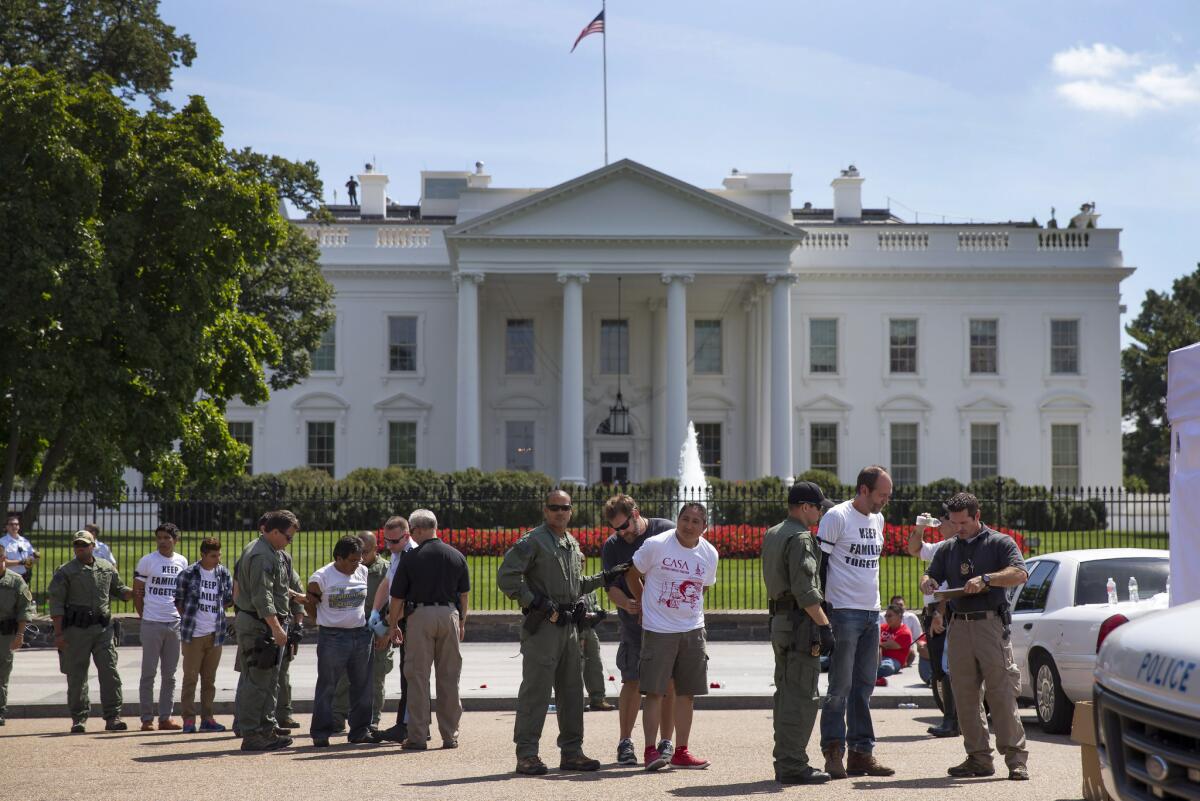Opinion: What Obama should consider as he contemplates immigration directives

So, back to that immigration mess.
President Obama, frustrated with the quagmire that is Congress, on Wednesday reiterated his intent to address by the end of the year the nation’s failed immigration system through directives and executive actions. The conventional analysis is that taking such steps would destroy any chance that the soon-to-be Republican Congress would work with him on a meaningful legislative overhaul of the immigration laws, which is what really needs to happen. Yet few Republicans have been talking about immigration reform in their post-election speeches and interviews, so it’s unclear whether they intend to address the issue (and does anyone really think compromise is on the GOP agenda?).
If Obama does go it alone, he will need to move carefully, and within the framework of his defined powers. Still, presidential actions can only nibble at the edges, such as creating or revising regulations and protocols under the existing law, ordering deportation deferrals to prioritize cases in the underfunded and overwhelmed enforcement system, and other bureaucratic tweaks.
Obama’s critics keep calling on him to “enforce all the immigration laws.” That’s a nice sound bite, but reality precludes it. The system is swamped and can’t keep up with the cases it already has. According to the Pew Research Center, the U.S. has deported more than 4 million noncitizens since 2001, yet there are still at least 11.3 million people here without legal permission. And with an immigration court backlog of over 400,000 cases, and an average case duration of 567 days, clearly the immigration enforcement system isn’t effective, despite the $18 billion the federal government spends each year on it (some $12 billion on Customs and Border Protection alone).
According to number-crunching of Census data by the Migration Policy Institute and Pew, there are between 11.3 million and 11.7 million illegal immigrants of all ages and national origins in the U.S. (about one quarter of them are in California). About 60% of the illegal population is from Mexico and an additional 11% is from Central America (mostly Honduras, Guatemala and El Salvador). The median tenure for the estimated 10.4 million adult illegal immigrants is nearly 13 years, up from nearly eight years a decade earlier (pre-recession, before the influx slowed considerably).
Significantly, 6 in 10 of the adults have been here for at least a decade, a third of those for more than 20 years. Of the total adult population, 9.6 million to 10.5 million people (the estimates vary because of different counts by the two organizations) aren’t eligible for Deferred Action for Childhood Arrivals or Temporary Protected Status, based on home country conditions, and thus are open to deportation if caught by immigrations officers. Some 3.3 million deportable adults live with their U.S.-born children under age 18, and nearly 2.7 million of those adults have been here more than 20 years.
Clearly, the bulk of illegal immigrants in the country – an estimated 4 in 10 may have entered legally but failed to leave as required – form a stabilized population, with jobs, in many cases families, and roots in American communities.
So, does it make sense to uproot more than 10 million people?
Polls show that most Americans believe illegal immigrants should be offered a path to citizenship with some conditions, including, usually, paying a fine, and having a clean criminal record. But to take the “enforce all the laws” argument – backed by 20% of Americans – to its end, the government would be tossing out of the country people that most Americans think should be allowed to stay.
Obama has already tried to focus on deporting those with criminal records and histories of violence, with questionable results. Enforcement has shifted from the interior to the border, which is a reasonable refocus (those caught at or near the border tend not to try to return; those caught in the interior, who have been here longer and have roots, tend to try to re-enter). Obama has overseen the highest rate of deportations in recent history, a tactic generally perceived to have been to show congressional conservatives that he is enforcing the existing laws in hopes of propelling immigration reform. When the Senate immigration bill stalled in the House, Obama put in place the DACA program, which was a “light” version of the similarly stalled DREAM Act, granting deferred status to many of those brought here as children.
It’s pretty clear that Obama has the authority to use executive orders or simply change internal prosecutorial discretion policies to prioritize how the immigration laws get enforced. One leaked internal memo suggests there’s pressure within the administration to review and reinterpret regulations the executive branch created 20 and 30 years ago that would let some people in the process of trying to get legal do so faster, and without leaving the country. And it could adopt “parole in place” for others who are waiting for the backed up system to make a decision, granting them the right to work while they wait, etc.
But that’s a drop in the bucket, and really doesn’t address the scope of the problem. Most illegal immigrants haven’t entered the immigration system, so those tweaks would affect only a small slice of the population.
As a guiding principle, the president should focus on preserving families and leaving alone those who most Americans wouldn’t mind seeing as fellow citizen, or at least fellow legal residents: those who don’t have significant run-ins with the law, who have deep connections such as U.S.-born children, and who are working and productive members of society. The government should let them stay until a political solution has been reached.
There is an argument to be made that not pursuing those here illegally is tantamount to rewarding lawbreakers. As theory, that makes sense. As a matter of political and practical action, it does not. Even if the government could magically remove 11.3 million people, it would create havoc from family disruptions to community estrangements to economic disorder. Imagine, for instance, the cost and availability of fresh produce and other foodstuffs if undocumented migrant workers were no longer in the fields or the packaging plants. What would happen to families relying on caregivers who get bounced? Landscaping, construction, transportation and other industries would falter as well.
So here are a few steps the president could take:
- Expand DACA. Molded after the DREAM Act, under DACA illegal immigrants brought here as kids by their parents can get two-year renewable deferrals (the criteria: arrived before age 16; younger than 31 by June 15, 2012; had lived in the country for five years since the DREAM Act was proposed in 2007; have at least a high school diploma or in the military; no serious crime convictions). By tweaking those requirements (residence since 2009; arrived before age 18; eliminate maximum age of 31; eliminate education component), the Migration Policy Institute estimates another 3.1 million people could be eligible for deferrals (1.9 million if the education requirement remained in place).
- Expand DACA beyond child arrivals, and base it on tenure; whether the immigrant has close family ties to legal residents or citizens; or has potential eligibility for a green card as a relative of a U.S. citizen. The number affected would change depending on where the length of residence cut off is established. At 10 years, that would mean another 5.74 million people would be eligible for deferrals.
- Abandon the Secure Communities program, which has failed in its fundamental mission of trying to ferret out violent illegal immigrants while leading to deportations of those with minor infractions, such as traffic tickets.
- Refocus on removing the truly dangerous, and those who will be more likely to damage society than enhance it (those with violent pasts, drug-dealing records, no history of stability or employment). The government supposedly is doing this, but there have been repeated anecdotal evidence that the net is still cast too wide.
- Continue to fine-tune the E-Verify system so that it is reliable, but only in tandem with these other measures. The goal is to bring people out of the shadows, not use E-Verify as a tool to root out people who might otherwise qualify for deferral status.
- Minimize the reliance on a detention system for ensnared illegal immigrants and let those who pose no risk to society be released to family members or sponsors as their cases work through the system. Immigration violators do not enjoy the protections of the Constitution, such as due process, but that doesn’t mean they should be jailed indefinitely for, in the case of many, the crime of fleeing violence and threats for a chance at safety. Especially in a system built on quotas to fill beds.
Follow Scott Martelle on Twitter @smartelle.




